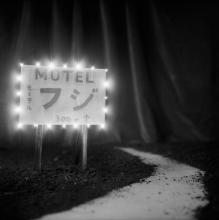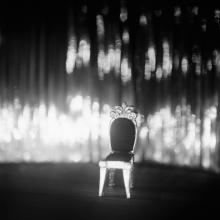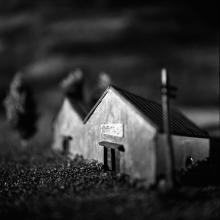Safe Playground, by Miyuki Okuyama
In this article Miyuki Okuyama, in addition to telling her childhood in a small village in northern Japan, explains her personal vision of photography. For Miyuki Okuyama, instead of documenting some kind of tangible reality, photography provides an access to a parallel world in which we can lose ourselves in our dreams and fantasies.
“Safe Playgroud”, the series of photos described in the essay, is entirely built and staged at home, (in a certain way like the dark worlds by Hyeyoung Kim, but in a much more realistic style), creating beautiful mysterious micro-worlds, explicitly in contrast to the accurate organization of Netherlands, the country where Miyuki Okuyama lives today.
Following text and photos by Miyuki Okuyama.
Contrary to the generally accepted purpose of photography, that is to record the present reality, my photographs are created in order to express rather inner, invisible reality. Actually a Japanese art director Shigeo Goto described my images “psycho-grapy.” One of my photo series titled “Safe Playground” is staged photography, and they are created aiming at triggering psychological effect in a viewer’s mind, such as childish fear, anxiety, and vague nightmares etc. These photographs trace the vestiges of memories which submerged in our sub-consciousness.
It is more important for me how something appears in the image than what it really is. That is the way I often create anonymous places or peripheral corners of an ordinary city in the images. My attempt is to summon previously mentioned feeling like fear and anxiety, and collective memory. One manner of this attempt is to make images somewhat familiar to anyone. Old hospital building, a signal box standing on railway, a roadside motel sign, a lit circus tent are all rather insignificant subjects which anyone may have seen somewhere, sometime.
As I wrote, my images are more of psychological representation than the representation of tangible reality. My ambition is to create images of a parallel world in which to lose ourselves in our own thoughts, fantasies, fears, dreams and memories. For the photo series “Safe Playground,” inspiration comes from my own memories, irrational childhood dreams and fears as well as fantasies. I spend my childhood and youth in a small village in northeast Japan. For me, this was a magical and somehow haunted place, just as the photo serried “Kamaitachi” by a Japanese photographer Eikoh Hosoe. In the works of Hosoe, one sees a strange panorama of an imaginary village, richly filled with references to old tales and superstitious, odd characters, who remind me of a man called Tadashi, a man with mild retardation in my neighborhood. Also a Japanese film and theater maker (also a poet and writer) Shuji Terayama created many of his writing and films (“Death in the Country” for instance) based on his childhood and youth in a small town in Aomori region. Both Hosoe and Terayama are from Tohoku region (northeast) of Japan as I am.
I do not know how exactly to explain, but my region has both charm and horror of a remote area. There is one good example of what it was like there: As a child, I was raised in a traditional farm household, where four generations lived under one roof. Not only my mother, but also my grandmother and my great-grandmother took care of me and my younger sister. I still remember my great-grandmother singing in old dialect lullabies. She said, “go to sleep child before the one-eyed demon comes to you. He’s standing already under our neighbor’s eaves.” This is one of the memories with dark undertone which are also fascinating.
In “Safe Playground,” the images are predominated by darkness, which is symbolically associated with human subconscious, and as the title “safe playground” literally tells that the images are the places to temporally relief human emotions (fear, anxiety, of course) in its suspended disbelief. For this reason, my works may have resemblance to the famous tales like “Little Red Riding Hood.” The tale provided readers a place to experience danger (particularly to young girls) and even enjoy it in safety. The author Charles Perraut concluded the tale:
“Moral: children, especially attractive, well bred young ladies, should never talk to strangers, for if they should do, they may well provide dinner for a wolf. I say “wolf,” but there are various kinds of wolves. There are also those who are charming, quiet, polite, unassuming, complacent, and sweet, who pursue young women at home and in the street. And unfortunately, it is these gentle wolves who are the most dangerous one of all.”
As Perraut suggests the danger of a “wolf,” my photos also may remind a viewer of figures like a kidnapper, a false prophet, Bluebeard etc. These “archetype” of modern day are invisible yet are suggested in those images. In his famous novel “Lolita,” Vladimir Nabokov wrote, “My Chère Dolores! I want to protect you, dear, from all the horrors that happen to little girls in coal sheds and alley ways, and alas, comme vous le saves trop bien, ma gentille, in the blueberry woods during the bluest of summers.” (Vintage International, New York, 1955) These “coal sheds” or “alley ways” are exactly what a viewer sees in “Safe Playground.”
The series “Safe Playground,” besides subconscious fear as its central subject, has been motivated by the way contemporary society is structured. I started this series after I came to the Netherlands. I was devastated by the fact that I cannot find places to take photographs. This country is thoroughly too well organized. Then I have decided to make up interesting places myself. These images are all created in my studio, on my worktable, to be precise. Being in a different culture motivated me to do all these troubles of photographing (constructing the models, setting the scenes, shooting and more re-shooting).
Where I grew up, as I have already mentioned, is a small conservative country village. Compare to such backcountry, my new home seemed overly organized and urbanized. Despite its modernity, it seems something is missing, perhaps, shadows and ambiguity, and definitely the autonomy of individual spaces. In the Netherlands, everything must be controlled; new suburban town with straight and square city plan, streets are brightly lit at night, and even the trees in groves are lined geometrically. While the farmers of my home are free to build sheds with reused materials, Netherlanders have no such freedom. In this country, monstrous civilization is exterminating shady places. After coming to the Netherlands, I have come to realize how important to have ambiguous places near me, where human feelings can be freed.
“Psycho-graphy” may be macabre and ominous, yet it can also be intriguing and evocative. It is obviously different from “photography,” for it represents the alternative reality instead of the reality that surrounds us. Despite the darkness in the images, they look strangely familiar and tender, because we all posses such darkness within. My photographs reveal such simple fact that we all have dusky depth filled with long-discarded fears in our minds.











